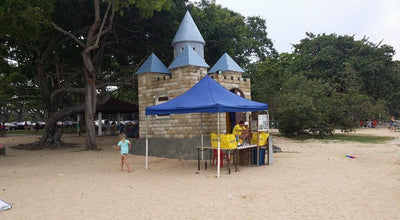Find out how the Sembawang Naval Base influenced the development and history of Sembawang on the National Heritage Board's latest heritage trail.

Photo Credit: Tony Dyer and Sofea Abdul Rahman
Sembawang, which derived its name from the Mesua ferruginea or the Sembawang tree, has also been home to people from all walks of life – from seafaring villagers who dwelt in kampongs; Asian dockyard workers from Kerala and Hongkong who lived at quarters along Canberra Road; to British naval officers who stayed in black-and-white houses – adding to the area’s rich history and cultural diversity.
Discover Sembawang’s naval history and diverse communities in the National Heritage Board’s (NHB) new Sembawang Heritage Trail. The trail features 31 trail sites and nine heritage trail markers, which invite trail-goers to explore Singapore’s northern coastal town from when it was first mentioned in maps in the early-1800s, to the decades before and after World War II.
Influence Of The Naval Base
Sembawang was developed into an important naval facility for Britain’s Far East Fleet during the pre- and post- World War II decades. Many landmarks of the former naval base still exist today. The following are highlights from the trail.
Beaulieu House

Photo Credits: National Heritage Board
Beaulieu House was built in the 1910s by businessman Joseph Brooke David, when it was first used as a holiday retreat. It was later taken over by the British navy and served as a home to several military officials, before becoming the residence of the Chief-of-Staff of the Far East Fleet in the 1960s.
Today, it is a restaurant that sits within the Sembawang Park, where a unique Battleship Playground also in the vicinity.
Former Admiralty House

Photo Credits: National Heritage Board
Gazetted as a National Monument in 2002, the Former Admiralty House constructed between 1939 and 1940 by the British Royal Navy. It was built to house the most senior officer at the former Sembawang Naval Base, and was originally known as Navy House or Canberra House.
The monument will be part of an integrated community hub for Sembawang called Bukit Canberra.
Sembawang Shipyard / Sembcorp Marine Admiralty Yard

Photo Credits: National Heritage Board
In 1967, Britain announced that it would withdraw its military forces from Singapore by the mid-1970s. As part of this process, the naval base’s dockyard was transferred to the Singapore government in 1968.The government established a new company, Sembawang Shipyard, to operate the dockyard as a commercial enterprise, and this way renamed Sembcorp Marine Admiralty Yard in 2015.
Influence Of The People


Photo Credits: (top) Tony Dyer and Sofea Abdul Rahman, (bottom) National Heritage Board
The trail also tells the stories of the many communities who settled in the area through the decades, including its earliest known inhabitants – the Orang Seletar; planters and boatmen who grew gambier and ferried passengers and goods; villagers of coastal kampongs like Kampong Tanjong Irau, Kampong Tengah and Kampong Wak Hassan; as well as the British naval officers and dockyard workers from Singapore, Malaya, India and Hong Kong.
The different cultures and communities resulted in the establishment of schools, associations and religious institutions.
Holy Tree Sri Balasubramaniar Temple

Photo Credit: Loh Koah Fong
The temple traces its origins to 1962, when P. Karuppiah, a dockyard worker, dreamt of Lord Murugan and a golden cobra under an elantha (jujube) tree. He then found the tree of his dream near Canberra Road and set up an altar
beneath it. Hindu dockyard workers began to pray at the altar and later built a wooden shed to house the shrine.
Devotees later raised funds to build a proper temple, which was consecrated in 1971.
Masjid Naval Base - Masjid Assyafaah

Photo Credits: National Heritage Board
The Masjid Naval Base at the former Delhi Road opened in 1968, the result of efforts by Muslims in the base’s police force. This was demolished in the 2000s after the completion of Masjid Assyafaah.
Masjid Assyafaah stands out as a mosque that integrates Islamic symbols with
contemporary architecture. Instead of a traditional minaret, the mosque has a 33-metre high steel tower bearing a star and crescent moon.
Masjid Petempatan Melayu Sembawang

Photo Credits: Richard Kuah
Opened in 1963, Masjid Petempatan Melayu Sembawang was built by the residents of Kampong Tengah, and is the only surviving landmark of the
former village today.
 \
\
Photo Credits: National Heritage Board
Here, you will also find the oldest (allegedly) rubber tree in Singapore.
Other Landmarks on the Sembawang Heritage Trail
Through 3 thematic, bite size routes, trail-goers can embark on an adventure according to their interest and time. To facilitate your journey, you may wish to download The Sembawang Heritage Trail’s companion guide and map (the map is available in four languages) from NHB’s heritage portal, Roots.gov.sg. Printed copies of the guide will also be available for a limited period at Sembawang Community Club, Sembawang Town Council and Canberra Community Club.
Historical landmarks of Sembawang
(2 hours on foot and with public transport)
Sembawang houses many historical landmarks established by the British and local communities, and is home to the only natural hot spring park in Singapore. This trail introduces you to these sites that tell of major milestones in Sembawang’s past.
- Holy Tree Sri Balasubramaniar Temple (Recommended starting point)
- Sembawang Strip
- Former homes in the naval base
- Former Sembawang Shipyard
- Sembawang Shopping Centre
- Sembawang Hot Spring Park
Communities of Sembawang
(3 hours on foot and with public transport)
Since the 19th century, Sembawang has been home to many communities, from coastal villages to British families based at the former naval base. This trail brings you through these former neighbourhoods and highlights buildings that were once part of these northern communities. Stops include:
- Former Admiralty House (Recommended starting point)
- Former homes in the naval base
- Masjid Petempatan Melayu Sembawang
- Former Kampong Tengah Holiday Camp (now PAssion WaVe @ Sembawang)
- Sembawang Strip
From Dockyard to Shipyard
(2 hours 30 mins on foot and with public transport)
Sembawang Naval Base, which opened in 1938 and closed in 1971, occupied much of Sembawang’s northern coast. The base included HM Dockyard, Singapore, a ship repair facility which was transferred to the Singapore government in 1968, when it became known as Sembawang Shipyard. This trail takes you to various landmarks that were part of the former naval base.
- Former Admiralty House (Recommended starting point)
- Masjid Assyafaah
- Former Aggie Weston’s Royal Sailors’ Rest
- Former Sembawang Shipyard
- Former Sembawang Fire Station (within Sembcorp Marine Admiralty Yard)
- Former homes in the naval base
- Sembawang Park and Beach
- Beaulieu House and Beaulieu Jetty
If you like to explore more heritage trails in Singapore, do check out this list of 15 fascinating heritage trails for families.







